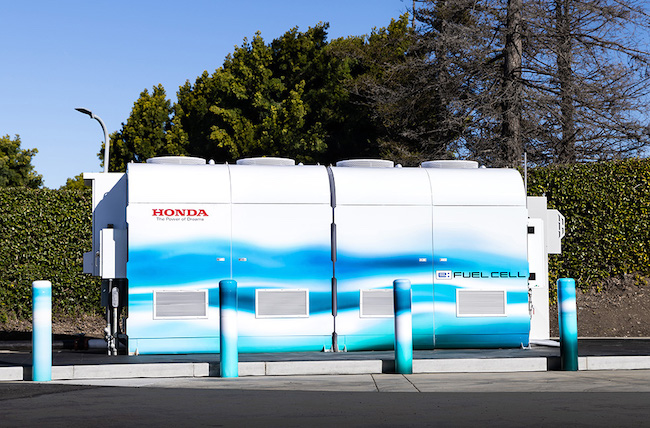
Torrance, Calif., Mar 6, 2023 – (JCN Newswire via SEAPRWire.com) – Honda today began operation of a stationary fuel cell power station on its corporate campus in Torrance, Calif., marking the company’s first step toward future commercialization of zero-emission backup power generation. The initiative leverages Honda’s hydrogen fuel cell technology expertise and contributes to the company’s global goal to achieve carbon neutrality for all products and corporate activities by 2050.
 |
Now fully operational as a demonstration program, Honda’s fuel cell power station supplies clean and quiet emergency backup power to the data center on the campus of American Honda Motor Co., Inc. In the coming years, Honda will begin applying a next-generation stationary fuel cell system to Honda manufacturing facilities and data centers globally, thereby reducing the company’s greenhouse gas emissions.
The demonstration stationary fuel cell unit has a capacity of approximately 500kW and reuses the fuel cell systems of previously leased Honda Clarity Fuel Cell vehicles, with a design that allows the output to increase every 250kW packaged with four fuel cells. It features the flexibility to change the layout of the fuel cell units to suit the installation environment and to accommodate cubic, L-shaped, Z-shaped, and other packaging configurations. Future stationary FC units intended for commercialization will utilize Honda’s next-generation FC system jointly developed with General Motors and also set to power an all-new fuel cell electric vehicle (FCEV) based on the Honda CR-V coming in 2024.
Over the last few years, the power requirements of data centers have been growing rapidly due to the expansion of cloud computing and big data utilization, and the need for backup power sources has been increasing from the perspective of business continuity planning (BCP). The Torrance fuel cell station also serves as a proof of concept for future commercialization of the power generation unit.
“We believe there’s great promise in hydrogen fuel cells for backup power and offsetting potential peak power events,” said Koji Moriyama, project lead of the stationary fuel cell and principal engineer with American Honda R&D Business Unit. “By installing and utilizing our core technology, the fuel cell system, in various applications such as stationary power generation, Honda aims to stimulate hydrogen usage and provide clean energy for potential commercial customers.”
Benefits of Hydrogen Fuel Cells as Backup Power
Data centers require high-quality and reliable power, where any disruption in power supply can lead to downtime or problems such as data corruption and damage to servers. Typical stationary backup generators rely on diesel fuel, which result in higher carbon emissions and local air pollutants. Backup power systems utilizing hydrogen fuel cells offer a promising future for clean, yet reliable and high-quality power generation, especially when operating on so-called “green hydrogen”(1) made from renewable sources, with water vapor as the only emission.
Hydrogen can be stored and transported with a high energy density, and can be refilled in a short time. The “hydrogen circulation cycle,” which starts with renewable energy, consists of three phases – “generate,” “store / transport” and “use.” Starting with the use of water electrolysis technology, electricity derived from renewable energy sources can be converted into green hydrogen, making it less susceptible to fluctuations in power generation due to seasonality and weather conditions. It also becomes possible to transport the energy to where it is needed in the form of “green hydrogen” via transport by land, sea, and pipeline.
Reusing Fuel Cell System of Honda Clarity Fuel Cell Vehicles to Achieve Resource Circulation
Based on Honda’s “Triple Zero” approach, which consists of three focus areas – carbon neutrality, clean energy and resource circulation – Honda is striving to realize a circular / resource-recycling society that aims for zero environmental impact by 2050.
To realize resource circulation, Honda aims to create a closed loop, circular economy that maximizes the useful life of materials in Honda products – including the fuel cell systems of Honda Clarity Fuel Cell vehicles for the demonstration stationary fuel cell unit. By developing recovery systems to recapture materials of its products when they reach end-of-life, Honda can reuse, refurbish, repurpose and recycle them into new products and foster Honda’s circular economy.
Honda Initiatives to Expand Hydrogen Business
Honda is taking a proactive approach to increase the use of hydrogen as an energy carrier and will strive to expand its hydrogen business. Last fall, Honda announced that starting in 2024 it will produce(2) an all-new hydrogen fuel cell electric vehicle (FCEV) based on the recently launched, all-new Honda CR-V at its Performance Manufacturing Center (PMC) in Marysville, Ohio. The company has been developing hydrogen technologies and fuel cell vehicles for more than 30 years.
In addition to the continued applications to Honda fuel cell electric vehicles and the stationary power generation, Honda recently announced it will proceed with business development in the domains of commercial vehicles and construction equipment, as well.
Honda Commitment to the Environment
Honda is committed to addressing global environmental and energy issues by striving to realize carbon neutrality for all products and corporate activities by 2050. Toward this goal, Honda will strive to make battery-electric and fuel cell electric vehicles represent 100% of auto sales in the U.S. and globally by 2040.
Honda also is working to reduce the environmental impact of its business operations. To slash CO2 emissions from its North American manufacturing operations, Honda has entered into long-term virtual power purchase agreements (VPPAs) for renewable wind and solar power seeking to cover more than 60% of the electricity that Honda uses in North America. This enables the company to fully offset the remaining carbon intensive grid-supplied electricity used in its Ohio, Indiana, and Alabama automobile manufacturing operations. Honda also promotes environmentally responsible business practices with its suppliers and retail dealer partners across North America.
Learn more at https://csr.honda.com/environment/na-environmental-report/.
(1) Hydrogen produced by electrolyzing water using renewable energy, which emits no CO2 during the production process
(2) Using domestic and globally sourced parts
For more information, visit https://global.honda/newsroom/news/2023/c230306eng.html.
Copyright 2023 JCN Newswire. All rights reserved. (via SEAPRWire)